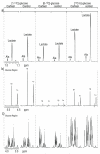Novel diagnostics of metabolic dysfunction detected in breath and plasma by selective isotope-assisted labeling
- PMID: 22304834
- PMCID: PMC3346854
- DOI: 10.1016/j.metabol.2011.12.010
Novel diagnostics of metabolic dysfunction detected in breath and plasma by selective isotope-assisted labeling
Abstract
Metabolomics is the study of a unique fingerprint of small molecules present in biological systems under healthy and disease conditions. One of the major challenges in metabolomics is validation of fingerprint molecules to identify specifically perturbed pathways in metabolic aberrations. This step is crucial to the understanding of budding metabolic pathologies and the ability to identify early indicators of common diseases such as obesity, type 2 diabetes mellitus, metabolic syndrome, polycystic ovary syndrome, and cancer. We present a novel approach to diagnosing aberrations in glucose utilization including metabolic pathway switching in a disease state. We used a well-defined prenatally exposed glucocorticoid mouse model that results in adult females with metabolic dysfunction. We applied the complementary technologies of nuclear magnetic resonance spectroscopy and cavity ring-down spectroscopy to analyze serial plasma samples and real-time breath measurements following selective (13)C-isotope-assisted labeling. These platforms allowed us to trace metabolic markers in whole animals and identify key metabolic pathway switching in prenatally glucocorticoid-treated animals. Total glucose flux is significantly proportionally increased through the major oxidative pathways of glycolysis and the pentose phosphate pathway in the prenatally glucocorticoid-treated animals relative to the control animals. This novel diagnostics approach is fast, noninvasive, and sensitive for determining specific pathway utilization, and provides a direct translational application in the health care field.
Copyright © 2012 Elsevier Inc. All rights reserved.
Figures



References
-
- Harris A, Seckl J. Glucocorticoids, prenatal stress and the programming of disease. Horm Behav. 2011;59:279–289. - PubMed
-
- Seckl JR. Prenatal glucocorticoids and long-term programming. Eur J Endocrinol. 2004;151(Suppl 3):49–62. - PubMed
-
- Seckl JR, Meaney MJ. Glucocorticoid programming. Ann N Y Acad Sci. 2004;1032:63–84. - PubMed
Publication types
MeSH terms
Substances
Grants and funding
LinkOut - more resources
Full Text Sources
Other Literature Sources
Medical

